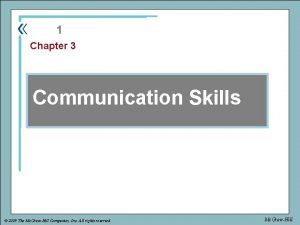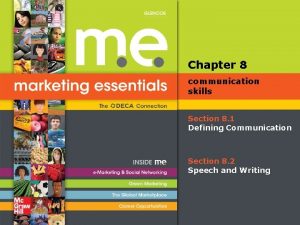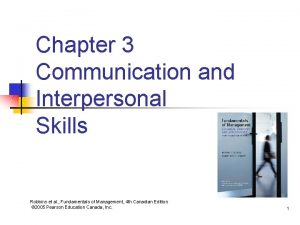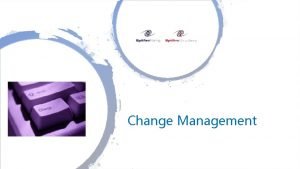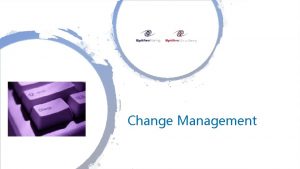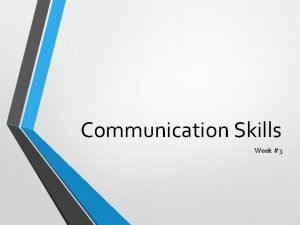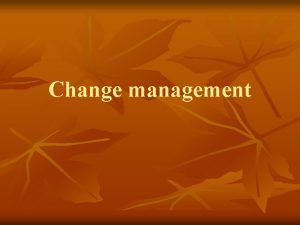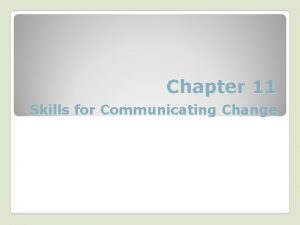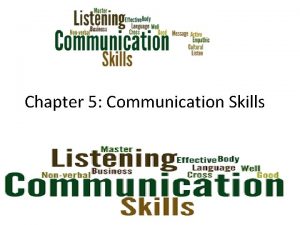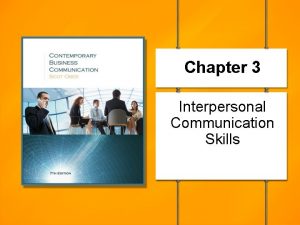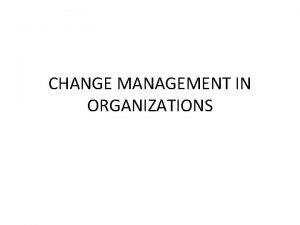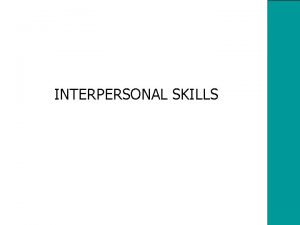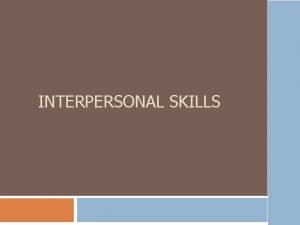Change Management Chapter 11 Communication Skills Communication Skills














- Slides: 14

Change Management Chapter 11 Communication Skills

Communication Skills • These skills are aimed at involving people and encouraging commitment to the change process § Unitarist (director, coach) vs. pluralist (navigator, interpreter) view • Pluralist – no amount of communication will change a clash of interests § What communication skills does each change image see as critical?

Key Communication Skills • Four key skills for communicating include: § § Listening Telling stories Selling change upward Toxic handling

Listening § There are four types of listening skills: • • suspending judgment, identifying assumptions, listening for learning, and Reflecting § Reflection exercise • Select a partner – Tell your partner a story about a time you lied or cheated – Justify your lying or cheating • Partner – suspend judgment and practice reflection – Identify the assumptions behind the justification – Share what you learned with your partner • Switch

Telling Stories § This is an effective way of helping employees learn from past changes & painting pictures of the future. • A key interpreter skill • Receives little training or management attention – why? • How can we train people in story telling? – Design an exercise

Selling Change Upward • “Issue selling” is a way of gaining senior management attention to changes initiated from below. § Message, timing, and channel are important • Elevator speech anyone? § Presentation techniques • Link to the logic of the business plan • Raise the proposal continuously • Package the issue incrementally § Bundling • Tie it to: – Profitability, market share, organizational image, or concerns of key stakeholders

Toxic Handling • Some people in organizations take on a role of handling the ill-effects of change processes and absorbing these as a way of shielding others from their negative impact. § § § Listening empathetically Suggesting solutions Working behind the scenes Carrying the confidences of others Reframing difficult messages • Have you ever seen a toxic handler in action or been helped by one?

Change Conversations • Different change conversations should be used at different stages of a change process. § Initiative conversations: these draw attention to the need for change. • An assertion, request, or declaration § Conversation for understanding: this communicates the type of changes needed and allows for a greater appreciation of why this type of change. • Specifies conditions of satisfaction • Enables participation and involvement • Confirms the interpretations place on the change

Conversation stages ctd. § Conversations for performance: this focuses on the actual change that is intended and how progress will be monitored. • • Promises are made Obligations are entered into Accountabilities are established Deadlines are set § Conversation for closure: this signals the end of the change • Acknowledgments, celebrations, rewards

Conversation stages ctd. § Omitting a stage may cause familiar communication problems in the change process • Such as…? § Issues • Identifying transitions – can they be nonlinear? • Different perceptions of what stage the organization is in • Impact of power imbalances • Can all managers be trained in all stages/skills?

Linguistic Modes & Imagery • Need for a balance of linguistic modes. § Ideals (express preferences), appeals (seek support), rules (seek to control), deals (bargaining) • Over-reliance on one mode leads to problems • Success comes from using different forms at different stages • The use of metaphors influences the images of change. § Need to be “in sync” with the type of change § These change images include: • • Machine: this is based on the “fix and maintain” view Developmental: this is based on the “build and develop” view Transitional: this is based on the “move and relocate” view Transformational: this is based on the “liberate and re-create” view

Communication with external stakeholders • Communicating with external stakeholders is an important (albeit often neglected) aspect of communicating change. • Research has focused on: § crisis management § impression management § corporate reputation

Some tactics • Impression management § Excuses, justifications, disclaimers, concealment • Crisis management § Competing accounts, statement of regret, dissociation (scapegoating) § Mortification, corrective action, bolstering image, denial, shifting the blame • What is best practice?

Tyco Case • Imagine you are the new CEO of Tyco (or Enron) § Write a script for your address to the shareholders after 18 months in the position. § Pay attention to the appropriate use of linguistic modes or metaphors in your “change conversation” • Be prepared to role play your script
 Organization change and stress management
Organization change and stress management Chapter 3 communication skills
Chapter 3 communication skills Setting in communication process
Setting in communication process Chapter 4 therapeutic communication skills
Chapter 4 therapeutic communication skills Chapter 3 communication skills
Chapter 3 communication skills Examples for physical change
Examples for physical change Physical and chemical change
Physical and chemical change Absolute change and relative change formula
Absolute change and relative change formula Integer operations
Integer operations Whats the difference between a chemical and physical change
Whats the difference between a chemical and physical change Change in supply vs change in quantity supplied
Change in supply vs change in quantity supplied Supply and demand curve shifts
Supply and demand curve shifts Enagic compensation plan
Enagic compensation plan Proactive vs reactive change
Proactive vs reactive change Physical change and chemical change
Physical change and chemical change

